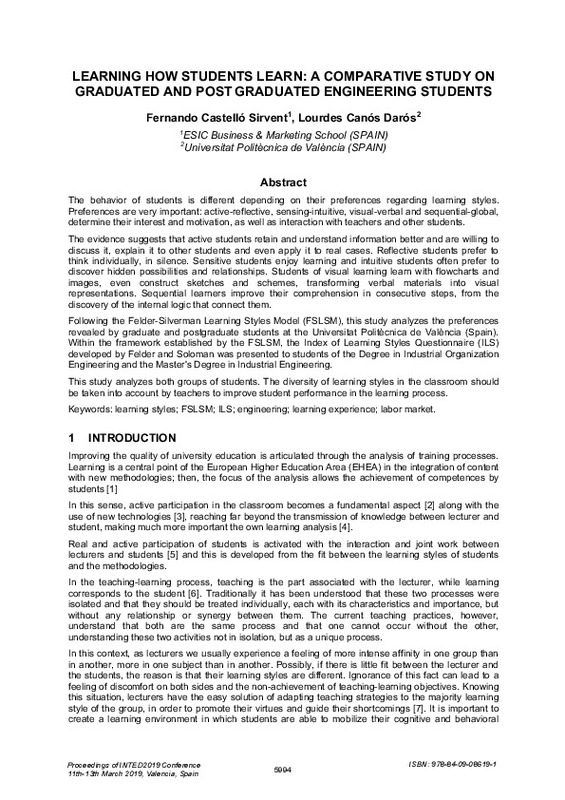JavaScript is disabled for your browser. Some features of this site may not work without it.
Buscar en RiuNet
Listar
Mi cuenta
Estadísticas
Ayuda RiuNet
Admin. UPV
Learning how students learn: a comparative study on graduated and post graduated engineering students
Mostrar el registro sencillo del ítem
Ficheros en el ítem
| dc.contributor.author | Castelló Sirvent, Fernando
|
es_ES |
| dc.contributor.author | Canós-Darós, Lourdes
|
es_ES |
| dc.date.accessioned | 2022-02-16T10:49:00Z | |
| dc.date.available | 2022-02-16T10:49:00Z | |
| dc.date.issued | 2019-03-13 | es_ES |
| dc.identifier.isbn | 978-84-09-08619-1 | es_ES |
| dc.identifier.issn | 2340-1079 | es_ES |
| dc.identifier.uri | http://hdl.handle.net/10251/180882 | |
| dc.description.abstract | [EN] The behavior of students is different depending on their preferences regarding learning styles. Preferences are very important: active-reflective, sensing-intuitive, visual-verbal and sequential-global, determine their interest and motivation, as well as interaction with teachers and other students. The evidence suggests that active students retain and understand information better and are willing to discuss it, explain it to other students and even apply it to real cases. Reflective students prefer to think individually, in silence. Sensitive students enjoy learning and intuitive students often prefer to discover hidden possibilities and relationships. Students of visual learning learn with flowcharts and images, even construct sketches and schemes, transforming verbal materials into visual representations. Sequential learners improve their comprehension in consecutive steps, from the discovery of the internal logic that connect them. Following the Felder-Silverman Learning Styles Model (FSLSM), this study analyzes the preferences revealed by graduate and postgraduate students at the Universitat Politècnica de València (Spain). Within the framework established by the FSLSM, the Index of Learning Styles Questionnaire (ILS) developed by Felder and Soloman was presented to students of the Degree in Industrial Organization Engineering and the Master's Degree in Industrial Engineering. This study analyzes both groups of students. The diversity of learning styles in the classroom should be taken into account by teachers to improve student performance in the learning process. | es_ES |
| dc.language | Inglés | es_ES |
| dc.publisher | IATED | es_ES |
| dc.relation.ispartof | INTED2019 Proceedings | es_ES |
| dc.rights | Reserva de todos los derechos | es_ES |
| dc.subject | Learning styles | es_ES |
| dc.subject | FSLSM | es_ES |
| dc.subject | ILS | es_ES |
| dc.subject | Engineering | es_ES |
| dc.subject | Learning experience | es_ES |
| dc.subject | Labor market | es_ES |
| dc.subject.classification | ORGANIZACION DE EMPRESAS | es_ES |
| dc.title | Learning how students learn: a comparative study on graduated and post graduated engineering students | es_ES |
| dc.type | Comunicación en congreso | es_ES |
| dc.type | Artículo | es_ES |
| dc.type | Capítulo de libro | es_ES |
| dc.identifier.doi | 10.21125/inted.2019.1464 | es_ES |
| dc.rights.accessRights | Abierto | es_ES |
| dc.contributor.affiliation | Universitat Politècnica de València. Departamento de Organización de Empresas - Departament d'Organització d'Empreses | es_ES |
| dc.description.bibliographicCitation | Castelló Sirvent, F.; Canós-Darós, L. (2019). Learning how students learn: a comparative study on graduated and post graduated engineering students. IATED. 5994-5998. https://doi.org/10.21125/inted.2019.1464 | es_ES |
| dc.description.accrualMethod | S | es_ES |
| dc.relation.conferencename | 13th International Technology, Education and Development Conference (INTED 2019) | es_ES |
| dc.relation.conferencedate | Marzo 11-13,2019 | es_ES |
| dc.relation.conferenceplace | Valencia, Spain | es_ES |
| dc.relation.publisherversion | https://doi.org/10.21125/inted.2019.1464 | es_ES |
| dc.description.upvformatpinicio | 5994 | es_ES |
| dc.description.upvformatpfin | 5998 | es_ES |
| dc.type.version | info:eu-repo/semantics/publishedVersion | es_ES |
| dc.relation.pasarela | S\419486 | es_ES |








